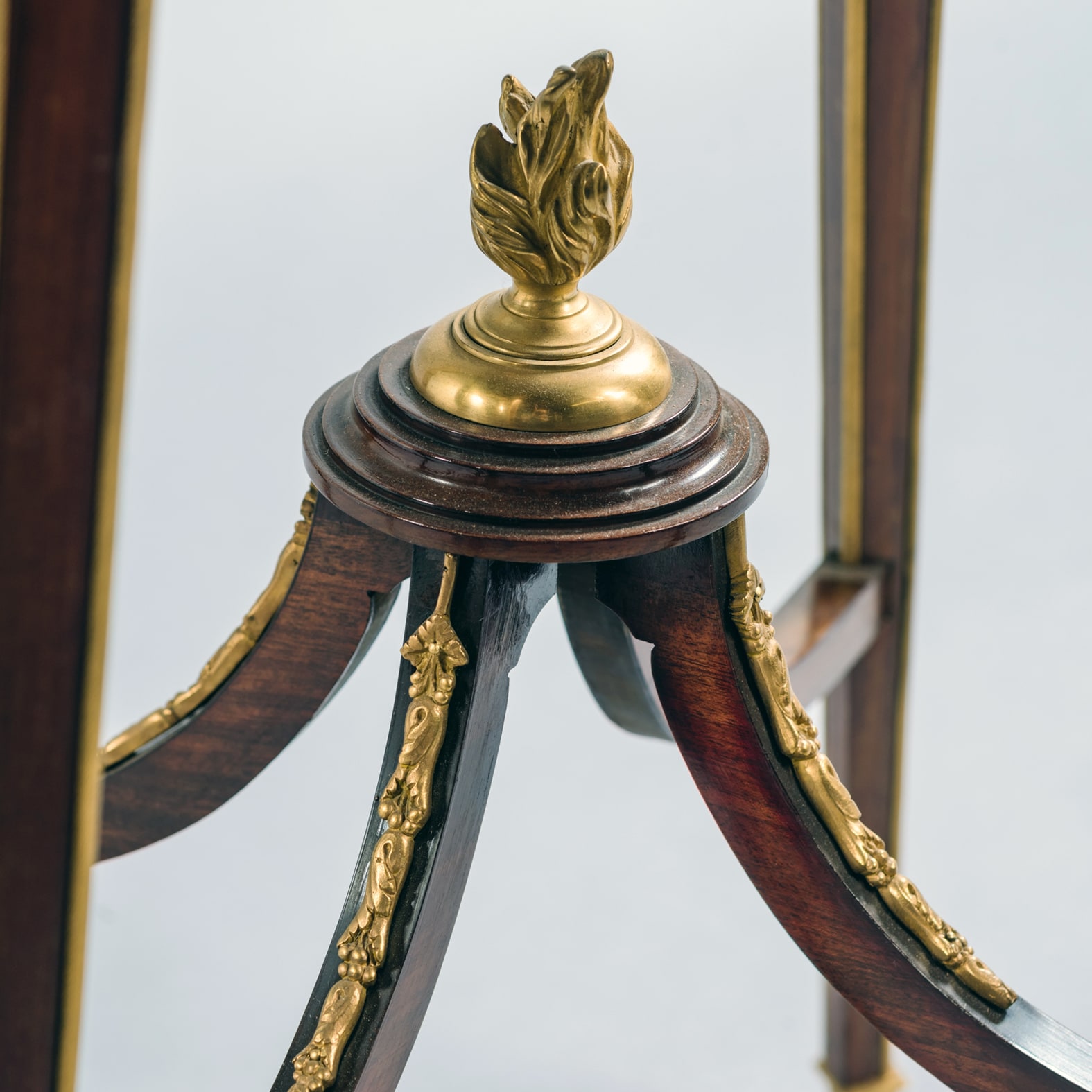François Linke
A Fine Pair of Louis XVI Style Gilt-Bronze Mounted Mahogany Stands
£26,000
A Fine Pair of Louis XVI Style Gilt-Bronze Mounted Mahogany Stands, Firmly Attributed to François Linke. This delicate pair of mahogany pedestals or...
Dimensions
Height: 86 cm (34 in)Width: 32 cm (13 in)
Depth: 32 cm (13 in)
Description
A Fine Pair of Louis XVI Style Gilt-Bronze Mounted Mahogany Stands, Firmly Attributed to François Linke.
This delicate pair of mahogany pedestals or stands each have an inset green onyx top above a frieze mounted with allegorical scenes of music. The frieze contains a pull-out slide and the stands are raised on square section tapering legs headed by musical trophies and united by a shaped stretcher with a flambeau finial.
An almost identical stand, with a green onyx top, typical slender legs and shaped stretcher is illustrated by Christopher Payne in François Linke (1855-1946) ‘The Belle Epoque of French Furniture’, p. 53, pl. 44. It is described as a stand or gaine and titled by Linke as ‘Pedestal Louis XVI acajou et bronzes dorés’, index number 56. It was available with or without a slide and a drawer, priced between 400 and 500 francs. A comparable version is also shown as a pencil drawing from Linke’s Daybook and illustrated in Payne, p. 474.
The ribbon tied musical trophies that head the legs of each stand was a mount frequently used by Linke on a number of different items of furniture including vitrines, commodes and a Bibliothèque Louis XVI, index number: 922.
French, Circa 1890.
Date
Circa 1890
Origin
France
Medium
Mahogany
François Linke (1855 – 1946) was the most important Parisian cabinet maker of the late nineteenth and early twentieth centuries, and possibly the most sought after cabinet maker of his period.
He was born in 1855 in the small village of Pankraz, in what is now the Czech Republic. Records show that Linke served an apprenticeship with the master cabinetmaker Neumann, then in 1875 at the age of 20 he arrived in Paris where he lived until he died in 1946.
It is known that the fledgling Linke workshops were active in Paris in the Faubourg St. Antoine as early as 1881, and during this time he supplied furniture for other more established makers such as Jansen and Krieger.
The quality of Linke’s craftsmanship was unsurpassed by any of his contemporaries and reached its peak with his spectacular stand at the Paris Exposition Universelle in 1900, where his Grand Bureau took the gold medal. He gambled his fortune and reputation on this stand, exhibiting several breathtaking items of furniture with sculptural mounts of the most exceptional quality and proportion. His gamble worked and his reputation was established to such an extent that Linke continued to be the pre-eminent furniture house in Paris until the Second World War.
As the Art Journal reported in 1900 on Linke’s stand:
‘The work of M. Linke … was an example of what can be done by seeking inspiration amongst the classic examples of Louis XV and XVI without in any great sense copying these great works. M. Linke’s work was original in the true sense of the word, and as such commended itself to the intelligent seeker after the really artistic things of the Exhibition. Wonderful talent was employed in producing the magnificent pieces of furniture displayed….’
The formation of Linke’s distinctive style was made possible by his collaboration with the sculptor Léon Messagé. Together Linke and Messagé designed furniture for Linke’s 1900 exhibition stand, with exuberant allegorical figures cast in high relief, that exemplified Linke’s ability to seamlessly merge the different mediums of wood carving, bronze and marquetry into a dynamic unified whole.
Today Linke is best known for the exceptionally high quality of his work, as well as his individualism and inventiveness. All of his work has the finest, most lavish mounts, very often applied to comparatively simple carcasses. The technical brilliance of his work and the artistic change that it represented were never to be repeated.
Bibliography:
Payne, Christopher. François Linke, (1855 – 1946), The Belle Époque of French Furniture, Antique Collectors’ Club, (Woodbridge, UK), 2003.
Meyer, Jonathan. Great Exhibitions – London, New York, Paris, Philadelphia, 1851-1900, Antique Collectors’ Club, (Woodbridge, UK), 2006; pp. 298 – 300.
Ledoux – Lebard, Denise. Les Ébénistes du XIXe siècle, Les Editions de l’Amateur, (Paris), 1984; pp. 439-43.
Revue Artistique & Industrielle, (Paris), July-August 1900.
Coral Thomsen, D. (ed), The Paris Exhibition 1900, The Art Journal, 1901; p.341.














 Print
Print


